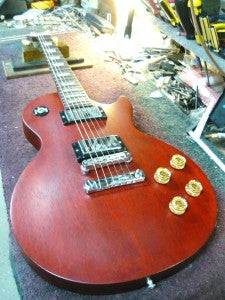Whats in a set up
Share
I get asked a lot "what do I get for my set up". I've been doing set ups for over 20 years now and in that time I've probably played, set up and repaired thousands of guitars, and I still get surprised by some. So, I'll put a few of these up for different types of guitars to give you an idea of what I do and what you get.
This is a pretty "typical" basic set up. This guitar is going into the studio tomorrow and needed to be set up in drop C#.
I start by playing the guitar "as is" when it comes in to see if there's anything that might be an issue.
I check the neck for bumps and issues before and after removing the strings. Any issues here need to be addressed before I go much further.
This neck was pretty good but had too much relief (forward bow) when strung up to normal pitch so a truss rod adjustment was going to be in order.
I do a basic fret dress as standard on any set up. If a guitar has 1 bad fret, it will be impossible to set up properly. I check for high spots and take them down. If there are serious low spots, I'll ring the customer and recommend a full fret dress. I charge $40 for this which is a small price to pay for what you get.
There's no point in doing a great set up with bad frets. It WILL buzz.
This neck was pretty good and only needed some slight high spots taken down.
Once they're flat the frets are recrowned and polished ready for the rest of the set up. I also moisturize the fretboard with a solution I make myself out of several different oils and a light cleaning fluid.
The tape is there to protect the finish and will be carefully removed now.
Because this guitar was going to drop C# and is a short scale I went for 12-56 strings to keep the tension and tone there. This of course means the nut slots had to be made bigger to suit the string gauge.
The truss rod was adjusted first to get the neck straight and then the nut slots were filed for width and height.
Because Gibsons NEVER come with their bridge radiused right to suit the fretboard and because of the thicker strings, the bridge radius was then set by filing the saddle slots the achieve the right radius.
It was nice to see this person strung their tailpiece THE PROPER way by feeding the strings from the bridge side and wrapping them over the tailpiece as Ted had intended when he designed this set up. I of course did it the same way as I do on ALL Les Pauls that customers let me do it to.
With the nut, truss rod and bridge all right, the action and intonation are all set. This can be time consuming on some guitars and quick on others.
I generally do all this and then let the guitar "settle" over night and come back to it the next day. They can move a little once all the this has been done so you can come back the next day and the action is a little different or the intonation might be slightly out.
With everything settled in the action is re-done and the intonation set with the strobe tuner.
The electrics are checked and cleaned if necessary. The guitar is given a quick clean and it's ready to go.
I charge $90 for a basic set up like this and it can make all the difference to a guitar that plays or sounds terrible or even one that's close but doesn't quite "feel"right..
I recommend that you get this done at least every 6 months if you play a lot and are serious about your music. Guitars move around a lot due to humidity and temperature so they NEED to be maintained.
If you are recording you REALLY should get this done before you go into the studio. You will hear those bum notes FOREVER once you've recorded with a badly set up guitar.
I do work for big touring bands who get their guitars (and amps) serviced every 3-4 months whether they need them or not because they know that badly serviced gear can and will stop a show or recording dead.









